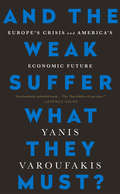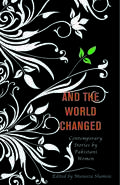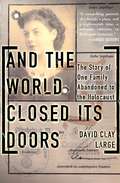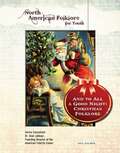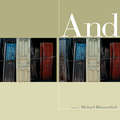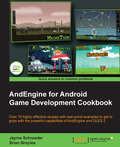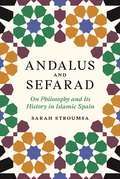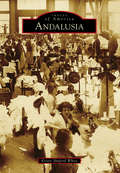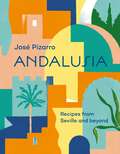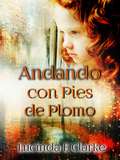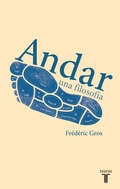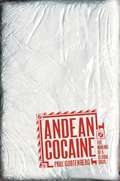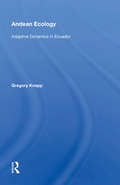- Table View
- List View
And the Weak Suffer What They Must?: Europe's Crisis and America's Economic Future
by Yanis VaroufakisA titanic battle is being waged for Europe's integrity and soul, with the forces of reason and humanism losing out to growing irrationality, authoritarianism, and malice, promoting inequality and austerity. The whole world has a stake in a victory for rationality, liberty, democracy, and humanism.In January 2015, Yanis Varoufakis, an economics professor teaching in Austin, Texas, was elected to the Greek parliament with more votes than any other member of parliament. He was appointed finance minister and, in the whirlwind five months that followed, everything he had warned about--the perils of the euro's faulty design, the European Union's shortsighted austerity policies, financialized crony capitalism, American complicity and rising authoritarianism--was confirmed as the "troika" (the European Central Bank, International Monetary Fund, and European Commission) stonewalled his efforts to resolve Greece's economic crisis. Here, Varoufakis delivers a fresh look at the history of Europe's crisis and America's central role in it. He presents the ultimate case against austerity, proposing concrete policies for Europe that are necessary to address its crisis and avert contagion to America, China, and the rest of the world. With passionate, informative, and at times humorous prose, he warns that the implosion of an admittedly crisis-ridden and deeply irrational European monetary union should, and can, be avoided at all cost.
And the World Changed
by Muneeza ShamsieThe only English-language anthology by Pakistani women published in the United States, And the World Changed goes beyond the sensational headlines to reveal the stories of Pakistani women. Immigrants and refugees, travelers and explorers, seasoned authors and fresh voices, the twenty-five writers in this volume are as dynamic and diverse as their stories.Sixty years have passed since the Partition of India, and it's clear that Pakistani writers have established their own literary tradition to record the stories of their communities. Famed novelist Bapsi Sidhwa portrays a Pakistani community in Houston, Texas, still struggling to heal from the horrors of Partition. In Uzma Aslam Khan's tale, a man working in a Karachi auto body shop falls in love with the magical woman painted on a bus cabin. Bushra Rehman introduces us to a Pakistani girl living in Corona, Queens, who becomes painfully aware of the tensions between established Italian immigrants and their new Pakistani neighbors. And during the anti-Muslim sentiment following 9/11, a young woman in newcomer Humera Afridi's story searches Manhattan's rubble-filled streets for a mosque.Filled with nostalgic memories of Pakistan, critical commentary about the world's current political climate, and inspirational hope for the future, the stories in And the World Changed weave an intricate, enlightening view of Pakistan, its relation to the West, and the women who travel between the two regions.Also contributing: Roshni Rustomji, Talat Abbasi, Tahira Naqvi, Fahmida Riaz, Rukhsana Ahmad, Shahrukh Husain, Sara Suleri Goodyear, Qaisra Shahraz, Fawzia Afzal Khan, Feryal Ali Gauhar, Maniza Naqvi, Sorayya Khan, Sehba Sarwar, Soniah Kamal, Bina Shah, Kamila Shamsie, Hima Raza, Aamina Ahmad, Sabyn Javeri-Jillani, Nayyara Rahman.Born and living in Pakistan, writer and critic Muneeza Shamsie has edited two other pioneering anthologies of Pakistani English writing.
And the World Closed Its Doors: The Story of One Family Abandoned to the Holocaust
by David Clay LargeMuch has been written about the West's unwillingness to attempt the rescue of tens of thousands of European Jews from the hands of the Nazis. Now David Clay Large gives a specific human face to this tragedy of bureaucratic inertia and ill will. In this masterpiece of Holocaust literature, Large tells the wrenching story of Max Schohl, a German Jew who in the years preceding World War II could not find a government that would allow his family to immigrate, despite wealth, education, business and family connections, a job offer from an American university, and herculean efforts by himself and his American relatives. After repeated but fruitless efforts to gain entry first to the United States, and then to Britain, Chile, and Brazil, Max died in Auschwitz, and his wife and daughters were sent to hard labor in Wiesbaden. Max left behind a unique collection of family letters and documents, which Large has brought together into a gripping, personal commentary on the evolution of the Holocaust in Europe and the hopelessly inadequate response from abroad.
And the World Went Dark: An Illustrated Interpretation of the Great War
by Steven N. PatriciaThis beautiful and evocative book gives an illustrated overview of the First World War, on land, on sea and in the air. With original drawings in full colour, Steven Patricia uses 30 years’ experience as a historical illustrator to give an informative and insightful account of the war, portraying the human faces of the participants and capturing moments in time with a vividness and immediacy that brings home both the emotional impact and the tragedy of war. Accompanied by soldier’s diary extracts and other contemporary literature, there are many drawings of the hardware of war: aircraft and airships, submarines and ships, guns and grenades. We also get a glimpse of weary officers relaxing in an RAF mess, see panicking sailors swimming desperately away from a sinking ship, soldiers stumbling across no-man’s land, and the dramatic scene of one of last great cavalry charges of any war, in Egypt. The role of animals is featured, including the importance of horses and rescue and messenger dogs. The text gives a concise introduction to the events of the war and why it started, with maps of the different fronts where fighting took place and a diagram of a trench system. Designed for readers with little familiarity of the conflict, this is a unique and unmissable book in the centenary of the ‘war to end all wars’.
And to All a Good Night: Christmas Folklore (North American Folklore for Youth)
by Bill PalmerDid you know that today's jolly Santa Claus was originally a Catholic bishop? Or that Santa Claus is connected to Saturn, an ancient Roman god? Or that in some places, Santa rides a camel? Christmas is a holiday of light and giving, and Santa Claus has become a traditional symbol for the season's deepest meanings. Learn more about:* Santa * the Christ Child * Christmas animals * the Wise Men * Christmas plants * Christmas songs and cards. Across North America, Christmas is an occasion for love and joy and celebration. Discover the traditions and folklore that make this holiday so special.
And: Life And Loathing In Greater Israel (American Poets Continuum)
by Michael BlumenthalThrough Michael Blumenthal&’s eyes we gain a renewed, childlike wonder at everything from plants, trees, and relationships to the most fundamental word in our vocabulary: AND. Blumenthal uses the conjunction to unify this collection and create a chanting, sonorous rhythm to his work. The result is a book of poems-as-hymns-and-praises.Michael Blumenthal holds the Mina Hohenberg Darden Endowed Chair in Creative Writing at Old Dominion University. His other books include the memoir All My Mothers and Fathers (HarperCollins Publishers, 2002), and the poetry collection Dusty Angel (BOA Editions, Ltd., 1999), for which he was awarded the Isabella Gardner Poetry Award. Blumenthal&’s new collection of poems, titled &“And,&” is the closest that the stoicism of Ecclesiastes will come to getting a 21st-century makeover. In it, there&’s a time to laugh and cry, scatter stones and gather them up, and all the rest. There&’s no point, though, in toil and hope beyond that. After reading these poems, which are designed with a cosmic sweep, you get the feeling that Blumenthal&’s plan is, as in Dylan Thomas&’s poem, eventually just to go gentle into that good night: &“Rage, rage against the dying of the light&” be damned.--THE JEWISH DAILY FORWARDMichael Blumenthal&’s stunning new book, And, is an Eliotic celebration of life in the world as continuum and progress. He achieves this through a simple and seductive meditation upon the conjunction, &“and,&” and the way it enriches the complexity of language as it shapes lived experience.--The Montserrat Review
And: Making a Difference by Leveraging Polarity, Paradox, or Dilemma
by Barry JohnsonAND is a resource for people who want to make a positive difference. How? By overcoming two obstacles: resistance to change and polarization. From a problem-solving perspective, either of these challenges could be overwhelming. From a Polarity Thinking™ perspective, both can be addressed by replacing Or with And when And is required. Regardless of the size of the system that you want to change, this book guides you through a clear process: <P><P> <li>Seeing: Is this an issue where And is required? <li>Mapping: How can I see a more complete picture and respect alternative views? <li>Assessing: How are we doing with this polarity? <li>Learning: What can we learn from our assessment results? <li>Leveraging: What action steps will we take to make a positive difference? <P><P> Reading this book will help you address resistance to your efforts to make a difference. Also, it will help you address chronic conflicts that become vicious cycles as both sides become more polarized. You will learn when and how to bring And into your efforts to make a positive difference. When done well, supplementing Or-thinking with And-thinking will help you convert the wisdom of those resisting change into a resource to support a more effective change. And-thinking will help you join polarized groups and convert a vicious cycle into a benefit for all. The results will benefit both groups and the larger system of which they are a part.
AndEngine for Android Game Development Cookbook
by Brian Broyles Jayme SchroederA Cookbook with wide range of recipes to allow you to learn game development with AndEngine quickly and efficiently. "AndEngine for Android Game Development Cookbook" is geared toward developers who are interested in working with the most up-to-date version of AndEngine, sporting the brand new GLES 2.0 branch. The book will be helpful for developers who are attempting to break into the mobile game market with plans to release fun and exciting games while eliminating a large portion of the learning curve that is otherwise inevitable when getting into AndEngine development. This book requires a working installation of eclipse and the required libraries, including AndEngine and its various extensions set up prior to working with the recipes.
Andalus and Sefarad: On Philosophy and Its History in Islamic Spain (Jews, Christians, and Muslims from the Ancient to the Modern World #62)
by Sarah StroumsaAn integrative approach to Jewish and Muslim philosophy in al-AndalusAl-Andalus, the Iberian territory ruled by Islam from the eighth to the fifteenth centuries, was home to a flourishing philosophical culture among Muslims and the Jews who lived in their midst. Andalusians spoke proudly of the region's excellence, and indeed it engendered celebrated thinkers such as Maimonides and Averroes. Sarah Stroumsa offers an integrative new approach to Jewish and Muslim philosophy in al-Andalus, where the cultural commonality of the Islamicate world allowed scholars from diverse religious backgrounds to engage in the same philosophical pursuits.Stroumsa traces the development of philosophy in Muslim Iberia from its introduction to the region to the diverse forms it took over time, from Aristotelianism and Neoplatonism to rational theology and mystical philosophy. She sheds light on the way the politics of the day, including the struggles with the Christians to the north of the peninsula and the Fāṭimids in North Africa, influenced philosophy in al-Andalus yet affected its development among the two religious communities in different ways.While acknowledging the dissimilar social status of Muslims and members of the religious minorities, Andalus and Sefarad highlights the common ground that united philosophers, providing new perspective on the development of philosophy in Islamic Spain.
Andalusia (Images of America)
by Kristy Shuford WhiteAndalusia's destiny was determined by the Conecuh River, when the 1841 "Harrison Freshet" brought floods and mosquito fever to the original county seat of Montezuma, forcing the move to higher ground. The new site was named Andalusia, and the post office officially relocated in 1844. Like many small towns, Andalusia's destiny could have once again been determined by an outside force--the economy. However, from timber to textiles, Andalusia has chosen to fight back against abandonment and vacancy and can now truly boast a unique and viable commercial downtown that continues to flourish while preserving its historic structures. Andalusia was awarded the 2013 Quality of Life Award by The Alabama Municipal Journal for purchasing the old Alabama Textile Mill (Alatex) in 2009 and for partnering with the chamber of commerce to create a new chamber office, welcome center, and national textile monument in tribute to the thousands who worked at the site and in textile mills all over the United States.
Andalusia: Recipes from Seville and Beyond
by José Pizarro‘A fantastic and heartfelt book, full of recipes that make you feel like Spain should be your home.’ – Tom KerridgeBordering Spain's southern coast, Andalusia is a place where the past and modernity blend together to form a rather magical destination. From sandy beaches to amazing architecture, buzzing tapas bars and flamenco dancers, it's full of passion.Not just a feast for the eyes, Andalusia is also a food-lover's paradise. In Andalusia, award-winning chef José Pizarro takes readers on a journey through it's most delicious dishes. Many of the dishes go back to Moorish times – or earlier – and each of the eight provinces has their own special dish. Try your hand at Pork loin with pear and hazelnuts, Prawns baked in salt with mango, chilli, coriander salsa, and a rather boozy Barbary fig margarita. Written in José's signature fuss-free style, this is genuine, bold-tasting Spanish food, easily made at home.Andalusia is all about simple pleasures: a glass of wine or sherry, a piece of cheese or ham, and good company. Set to the backdrop of beautiful location shots, Andalusia is a must for anyone who loves authentic, simple Spanish food.
Andando con pies de plomo
by Javier García Frutos Lucinda E Clarke“Andando con pies de plomo” es una autobiografía que cuenta la historia de una niña de la que han abusado mentalmente, que se casó con un clon de "Walter Mitty" que la llevó a vivir a países diferentes. Se mudaron de Inglaterra a Kenia, de Libia a Botsuana y luego volvieron a Sudáfrica. Necesitó mucho valor para sobrevivir en situaciones que a veces eran peligrosas y a veces humorísticas, pero siempre angustiosas. Tuvo una variedad de trabajos, diferentes tipos de casas, y fue millonaria y acabó en la ruina. Por un extremo, conoció a la realeza, recibió embajadores y ganó numerosos premios por sus escritos y sus programas de televisión. Por el otro extremo, tuvo que trepar a los vertederos, defender a esbirros y se las arregló para vivir en la selva africana con un bebé de siete semanas después de que la abandonaran, sin dinero ni recursos. Ella admite ser la cobarde más grande del mundo, pero se guió por su instinto de supervivencia y vivió para contar su historia. Este libro te hará reír y llorar, pero también explica el daño que una madre con un trastorno de personalidad que puede infligir a un niño. Sin embargo, no todo es pesimismo, y con suerte inspirará a otros que tampoco tuvieron un buen comienzo en la vida. Todos los nombres han sido cambiados para proteger tanto a los culpables como a los inocentes, ¡y eso incluye a la autora también!
Andar, una filosofía
by Frédéric GrosCaminar es mucho más que poner un pie delante del otro. ¿Y si solo se pudiera pensar bien a través de los pies? «Un admirable libro que entusiasmará incluso a los sedentarios empedernidos.» Le Monde des Livres Andar no exige ni aprendizaje, ni técnica, ni material ni dinero. Sólo requiere de un cuerpo, de espacio y de tiempo. Cada día son más los aficionados a caminar, y todos ellos obtienen los beneficios de esa propensión: sosiego, comunión con la naturaleza, plenitud... Andar. Una filosofía es un recorrido (a pie), filosófico y literario, en compañía de ilustres autores como Rimbaud, Thoreau o Kant cuyo hilo conductor es el simple hecho de caminar. Andar como experiencia de libertad, como acto solitario y propicio para la ensoñación, como motor de creatividad... Este libro es una celebración delpaseo y una reivindicación de virtudes elementales que parecemos haber olvidado en esta época de prisas y de monotonía. Desde un enfoque cultural, Frédéric Gros se adhiere a la corriente de lo slow y nos invita a valorar las ventajas de la lentitud. «Para ir más despacio no se ha encontrado nada mejor que andar. Para andar hacen falta ante todo dos piernas. Todo lo demás es superfluo. ¿Quieren ir más rápido? Entonces no caminen, hagan otra cosa: rueden, deslícense, vuelen». La crítica ha dicho...«Un hermoso libro escrito para aquellos que aún no han partido.»Le Figaro «Pasear y descansar en las aceras, entre los edificios, una celebración necesaria de la vida en la ciudad.»El correo de Andalucía «Un libro inclasificable en el que la luz de la mañana ilumina las ideas.»L'Express «Un admirable libro que entusiasmará incluso a los sedentarios empedernidos.»Le Monde des Livres «Un paseo tranquilo, al ritmo de un pensamiento cálido y pertinente, que de manera eficaz toma tintes de delicado reproche hacia una sociedad en la que la velocidad, con demasiada frecuencia, se confunde con el olvido de la veracidad de las cosas, del yo y de los demás.»Figaroscope «La fuerza de este libro consiste en invitarnos a inscribir nuesros pasos en itinerarios al mismo tiempo singulares y universales.»L'Humanité «Un libro tan agradable como profundo.»La Croix
Andean Cocaine
by Paul GootenbergIlluminating a hidden and fascinating chapter in the history of globalization, Paul Gootenberg chronicles the rise of one of the most spectacular and now illegal Latin American exports: cocaine. Gootenberg traces cocaine's history from its origins as a medical commodity in the nineteenth century to its repression during the early twentieth century and its dramatic reemergence as an illicit good after World War II. Connecting the story of the drug's transformations is a host of people, products, and processes: Sigmund Freud, Coca-Cola, and Pablo Escobar all make appearances, exemplifying the global influences that have shaped the history of cocaine. But Gootenberg decenters the familiar story to uncover the roles played by hitherto obscure but vital Andean actors as well--for example, the Peruvian pharmacist who developed the techniques for refining cocaine on an industrial scale and the creators of the original drug-smuggling networks that decades later would be taken over by Colombian traffickers. Andean Cocaine proves indispensable to understanding one of the most vexing social dilemmas of the late twentieth-century Americas: the American cocaine epidemic of the 1980s and, in its wake, the seemingly endless U.S. drug war in the Andes.
Andean Ecology: Adaptive Dynamics In Ecuador
by Gregory KnappThis book describes and analyzes the adaptive strategies of traditional and prehistoric farmers in one part of the Andes, in an effort to understand the varying interactions between people and their habitat over the last five hundred years.
Andean Entrepreneurs: Otavalo Merchants and Musicians in the Global Arena
by Lynn MeischNative to a high valley in the Andes of Ecuador, the Otavalos are an indigenous people whose handcrafted textiles and traditional music are now sold in countries around the globe. Known as weavers and merchants since pre-Inca times, Otavalos today live and work in over thirty countries on six continents, while hosting more than 145,000 tourists annually at their Saturday market. In this ethnography of the globalization process, Lynn A. Meisch looks at how participation in the global economy has affected Otavalo identity and culture since the 1970s. Drawing on nearly thirty years of fieldwork, she covers many areas of Otavalo life, including the development of weaving and music as business enterprises, the increase in tourism to Otavalo, the diaspora of Otavalo merchants and musicians around the world, changing social relations at home, the growth of indigenous political power, and current debates within the Otavalo community over preserving cultural identity in the face of globalization and transnational migration. Refuting the belief that contact with the wider world inevitably destroys indigenous societies, Meisch demonstrates that Otavalos are preserving many features of their culture while adopting and adapting modern technologies and practices they find useful.
Andean Foodways: Pre-Columbian, Colonial, and Contemporary Food and Culture (The Latin American Studies Book Series)
by John E. StallerThere is widespread acknowledgement among anthropologists, archaeologists, ethnobotanists, as well as researchers in related disciplines that specific foods and cuisines are linked very strongly to the formation and maintenance of cultural identity and ethnicity. Strong associations of foodways with culture are particularly characteristic of South American Andean cultures. Food and drink convey complex social and cultural meanings that can provide insights into regional interactions, social complexity, cultural hybridization, and ethnogenesis. This edited volume presents novel and creative anthropological, archaeological, historical, and iconographic research on Andean food and culture from diverse temporal periods and spatial settings. The breadth and scope of the contributions provides original insights into a diversity of topics, such as the role of food in Andean political economies, the transformation of foodways and cuisines through time, and ancient iconographic representations of plants and animals that were used as food. Thus, this volume is distinguished from most of the published literature in that specific foods, cuisines, and culinary practices are the primary subject matter through which aspects of Andean culture are interpreted.
Andean Hydrology
by Diego A. Rivera Alex Godoy-Faundez Mario Lillo SaavedraThis book describes the ecosystem of the Andean watersheds, covering the Californian valley, tropical Andes, and southern Andes. Case studies of the new methods and techniques used for hydrological research in the Andes are provided, and sustainability issues pertaining to Andean water resources are discussed in the context of climate change, social and economic issues, and public policy. Furthermore, the impact of economic development on the Andean ecosystem, specifically the effect on the water cycle and the water-energy-food nexus, are examined.
Andean Inspired Knits
by Helen HamannCreate dazzling knitwear designs with Andean Inspired Knits, a collection of patterns inspired by pre-Columbian textiles.
Andean Lives
by Paul H. GellesGregorio Condori Mamani and Asunta Quispe Huamán were runakuna, a Quechua word that means "people" and refers to the millions of indigenous inhabitants neglected, reviled, and silenced by the dominant society in Peru and other Andean countries. For Gregorio and Asunta, however, that silence was broken when Peruvian anthropologists Ricardo Valderrama Fernández and Carmen Escalante Gutiérrez recorded their life stories. The resulting Spanish-Quechua narrative, published in the mid-1970s and since translated into many languages, has become a classic introduction to the lives and struggles of the "people" of the Andes. Andean Lives is the first English translation of this important book. Working directly from the Quechua, Paul H. Gelles and Gabriela Martínez Escobar have produced an English version that will be easily accessible to general readers and students, while retaining the poetic intensity of the original Quechua. It brings to vivid life the words of Gregorio and Asunta, giving readers fascinating and sometimes troubling glimpses of life among Cuzco's urban poor, with reflections on rural village life, factory work, haciendas, indigenous religion, and marriage and family relationships.
Andean Meltdown: A Climate Ethnography of Water, Power, and Culture in Peru
by Karsten PaerregaardAndean Meltdown examines how climate change and its consequences for Peru's glaciers are affecting the country's water supply and impacting Andean society and culture in unprecedented ways. Drawing on forty years of extensive research, relationship building, and community engagement in Peru, Karsten Paerregaard provides an ethnographic exploration of Andean ritual practices and performances in the context of an altered climate. By documenting Andean peoples' responses to rapid glacier retreat and urgent water shortages, Paerregaard considers the myriad ways climate change intersects with environmental, social, and political change. A pathbreaking contribution to cultural anthropology and environmental humanities, Andean Meltdown challenges prevailing theoretical thinking about the culture-nature nexus and offers a new perspective on Andean peoples' understanding of their role as agents in the shifting relationship between humans and nonhumans.
Andean States and the Resource Curse: Institutional Change in Extractive Economies (Routledge Studies of the Extractive Industries and Sustainable Development)
by Gerardo Damonte Bettina SchorrThis volume explores institutional change and performance in the resource-rich Andean countries during the last resource boom and in the early post-boom years. The latest global commodity boom has profoundly marked the face of the resource-rich Andean region, significantly contributing to economic growth and notable reductions of poverty and income inequality. The boom also constituted a period of important institutional change, with these new institutions sharing the potential of preventing or mitigating the maladies extractive economies tend to suffer from, generally denominated as the “resource curse”. This volume explores these institutional changes in the Andean region to identify the factors that have shaped their emergence and to assess their performance. The interdisciplinary and comparative perspective of the chapters in this book provide fine-grained analyses of different new institutions introduced in the Andean countries and discusses their findings in the light of the resource curse approach. They argue that institutional change and performance depend upon a much larger set of factors than those generally identified by the resource curse literature. Different, domestic and external, economic, political and cultural factors such as ideological positions of decision-makers, international pressure or informal practices have shaped institutional dynamics in the region. Altogether, these findings emphasize the importance of nuanced and contextualized analysis to better understand institutional dynamics in the context of extractive economies. This book will be of great interest to students and scholars of the extractive industries, natural resource management, political economics, Latin American studies and sustainable development.
Andela: Africa's AWS for Talent
by Caroline Elkins Tarun Khanna Joyce J. KimFive years after the company's founding, Andela, a company that built and trained remote engineering teams, became arguably Africa's greatest technology unicorn. By January 2019, Andela raised $100 million in Series D funding. As Andela looked to scale in an increasingly competitive landscape, its goal was to democratize trust and become an "Amazon Web Services" (AWS) for software engineering talent. With their windfall investment and the advent of COVID, Andela had to figure out their "2.0 model" to permit scaling. How would Andela stack up in a growing landscape of global remote talent companies? Could Andela become not just Africa's, but the world's AWS for trusted software engineering talent?
Andengold: Bergbaufluch in (Post-)Bürgerkriegsländern Lateinamerikas ((Re-)konstruktionen - Internationale und Globale Studien)
by Dorothea HamiltonDer 2016 unterschriebene Friedensvertrag mit FARC in Kolumbien stellt das Land u.a. vor die Frage, welche Bedeutung der Ressourcenreichtum des Landes für den Aufbau einer friedlichen Gesellschaft spielen soll. Abgeleitet von den Erkenntnissen aus Peru wird untersucht, welchen Einfluss der legale und nicht legale Abbau von Gold auf die jeweiligen bewaffneten Konflikte hatte, wie sich deren Nutzung in der Friedenszeit wandelte und welche neuen Konflikte entstanden sind. Zum Umgang mit der ehemaligen Konfliktressource Gold gibt es divergierende Vorstellungen, die extraktivistischen und postextraktivstischen Ideen zugeordnet werden können, die in lokalen Konflikten enden. Der Fokus liegt auf der subnationalen, nach Abbauart differenzierten Untersuchung von Ressourcenausbeutung und Bürgerkrieg bzw. Postbürgerkrieg. Die Ergebnisse zu illegalem Bergbau zeigen, dass es sich dabei nicht um ein Bürgerkriegsphänomen handelt, sondern vielmehr um eine geduldete Praxis, die die Bewaffnung von Gewaltakteuren bedingt. Aber auch legale Ressourcenförderung, die nach Beendigung des Konflikts als Strategie der Friedensfinanzierung verstanden wird, führt zu ähnlichen negativen Auswirkungen, sodass von einem Bergbaufluch gesprochen wird.
Andere Sichtweisen auf Intersektionalität: Revisualising Intersectionality
by Magdalena Nowicka Elahe Haschemi Yekani Tiara RoxanneDas Buch hinterfragt die vermeintliche visuelle Evidenz von Kategorien menschlicher Ähnlichkeit und Differenz. Es bezieht Erkenntnisse aus den Sozial- und Kognitionswissenschaften sowie der Psychologie und Philosophie ein, um zu erklären, wie wir physische Unterschiede visuell wahrnehmen und zeigt, dass Wahrnehmung sowohl fehlbar als auch prozesshaft ist. Dazu bringen die Autorinnen Studien zur visuellen Kultur und künstlerische Forschung mit Ansätzen wie Gender, Queer und Trans Studies sowie postkolonialer Theorie miteinander ins Gespräch, um vereinfachte Vorstellungen von Identitätspolitik und kultureller Repräsentation zu verkomplizieren. Das Buch schlägt andere Sichtweisen auf Intersektionalität vor, um die Vorherrschaft von Kategorien der vermeintlich sichtbaren Differenz wie race und Geschlecht als analytische Kategorien infrage zu stellen.
